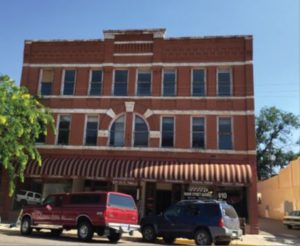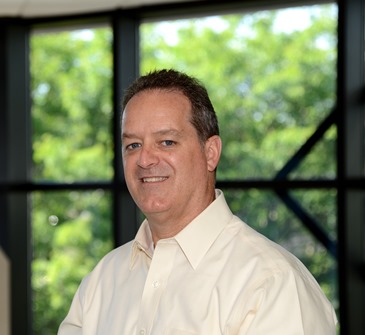This Guest Article for REVITALIZATION is by Brian McCarter.
In the spring of 2017, a group of out-of-state property investors purchased a historic three-story building in downtown Florence, Colorado.
Built in 1894 by James McCandless for his expanding mercantile business, the McCandless Building, as it is known, was also home to a shoe and clothing company, a hotel, offices, and a public hall.

A C-PACE project at this historic building in Colorado will improve the 124-year-old building’s energy efficiency by 85 percent.
Over the years, other businesses came and went, including a grocery store, a furniture company, a laundromat, and an upholsterer. There was even a handful of apartments.
By 2017, however, years of neglect had taken their toll, and the building stood mostly empty.
“The first-floor ballroom and commercial kitchen had been abandoned and stripped of equipment, and the top-floor skylight, which runs the length of the building, was broken,” said Vice President of Sustainability and Real Estate Broker Melissa Baldridge of GreenSpot Global, which facilitates land acquisition, financial and sustainability analysis, and developed and finished product sales. “As a result of the loosely-boarded skylight, pigeons were living—and dying—in the top two floors.”
Undaunted, the new owners intend to overhaul the 23,000-square-foot structure. Their plans include a ballroom, a commercial kitchen, dining, and short- and long-term rental units.
The owners also knew they needed to address the building’s aging systems. “Though thick-walled, the building had no insulation, and its mechanical systems were not only at the end of their useful life, but they also weren’t even commercial grade,” Baldridge said, adding that the building needed a substantial overhaul.
To fund the energy efficiency portion of the makeover, the owners turned to a new program designed specifically for this purpose. Commercial property assessed clean energy, or C-PACE, is a government-sponsored program that facilitates affordable, long-term financing for up to 100 percent of eligible energy improvement projects. “Once we learned about the Colorado C-PACE program, we recognized that C-PACE is the ideal way to add value to the building while lowering our operating costs,” said Craig Giles, who represents the building’s owners.
GreenSpot Global developed the C-PACE project for the building owners. The improvements, which include new insulation, LED lighting, window glazing, rooftop heating and cooling units, and a roof-mounted solar PV system, are projected to improve the building’s energy efficiency by a whopping 85 percent. This savings, in turn, will greatly reduce the owners’ energy costs—a significant benefit considering they plan to foot the utility bills for the apartment rentals.
New Resource Bank, a San Francisco-based triple-bottom-line bank, funded the investment, which totaled $616,844.
A New Program for Old Buildings
As property owners and investors know, breathing new life into an old building has multiple benefits. It can reduce urban sprawl. It can conserve resources. And it can preserve a historic space while contributing to neighborhood revitalization.
It can also be expensive.
Fortunately for the owners of the property in Florence and others like them, C-PACE programs are gaining traction across the country. While these government-sponsored programs won’t fund the cost of repairing ornamental plaster or replacing old millwork, they will make another potentially costly aspect of the upgrade—energy efficiency—economically attractive. In fact, well-designed C-PACE projects often pay for themselves because the utility bill savings outweigh the C-PACE payments.
The Challenge of Funding Energy Retrofits
According to the U.S. Energy Information Administration’s Annual Energy Outlook 2017, commercial and industrial buildings are responsible for more than a quarter of the primary energy consumed in the United States. The owners of these buildings know that outdated, inefficient equipment leads to inflated utility bills and less comfortable, less competitive buildings, which compounds the problem. Still, they often defer beneficial retrofit projects because they have no good way to pay for them.
Prior to C-PACE, commercial and industrial building owners had two primary options for funding an energy efficiency project. They could pay for it themselves, which meant diverting cash that had been earmarked for core business operations. Or, they could secure a bank loan, which typically requires 20 percent down and a personal guarantee. Such loans are also usually short term (e.g. five years), which is not long enough to provide an attractive return on investment for most energy efficiency projects.
Faced with a lack of economically attractive options, it’s understandable why many building owners choose to defer maintenance until their equipment fails completely.
A Better Way
Designed to encourage energy efficiency, water efficiency, and renewable energy projects in commercial and industrial buildings (whether historic or not), C-PACE solves the challenges of funding these projects by turning unwanted expenses into economically attractive investments. C-PACE does this in two ways. First, by facilitating 100 percent of the project’s cost—both hard and soft costs can be included—C-PACE saves the owner from having to come up with any money down, thereby preserving capital. Second, the financing spans up to 25 years, enabling an attractive return on investment. (The maximum term of C-PACE financing is set at the weighted average useful life of the improvements.)
C-PACE financing also appeals to building owners because the energy cost savings that result from the improvements typically cover all or a major portion of the PACE payments. And because C-PACE financing is property-based, the owner is not required to sign a personal guarantee. What’s more, the loan runs with the property, so owners can transfer the balance of the repayment obligation to a new owner if the property is sold. The financing can be combined with utility and government incentive programs, which is another added benefit for the building owner.
Although C-PACE programs vary from state to state, many offer third-party technical review services to ensure that the project’s savings and financial projections, which are typically provided by the energy efficiency or renewable energy contractor, were prepared using best practices. This independent quality assurance gives the building owner further confidence that the project is a sound investment.
The Nuts and Bolts: How Does C-PACE Work?
C-PACE programs are public-private partnerships, voluntary for all stakeholders. In a typical project, the financing is provided by a private capital provider in an open-market to ensure competitive terms, and is secured by a voluntary special assessment lien that is recorded against the property. Once the financing closes, the payments are billed as a separate line item on the property tax bill, or, increasingly, are repaid directly to the capital provider.
Because the repayment obligation is tied to a property assessment (similar to how a sewer assessment works), C-PACE requires legislative approval at the state level before projects can be financed. Most states have recognized that C-PACE projects offer multiple benefits to communities, including job creation, improved building stock, reduced greenhouse gas emissions, and improved air quality. Today, more than 30 states have PACE-enabling legislation on the books, and about half of those have active programs.
Eligibility
Multiple property types are eligible for C-PACE financing. They include commercial, industrial, and nonprofit buildings, such as houses of worship and private schools, and multifamily housing with five or more units. The specifics vary from program to program, so it’s important to check the guidelines of the state in which the building is located.
Improvements that are eligible for C-PACE financing are those that will be permanently affixed to the property and will lower the utility bill. The most common improvements funded with C-PACE financing include:
- Automated building controls;
- Boilers, chillers, and furnaces;
- Building envelope (insulation, windows);
- Combined heat and power systems (CHP);
- High-efficiency lighting;
- Hot water systems;
- HVAC upgrades and controls;
- Roof upgrades;
- Solar PV systems; and
- Water efficiency measures.
Some C-PACE programs will fund electric vehicle charging stations, seismic resiliency projects, and other measures not listed here, so it’s a good idea to check program guidelines when developing a project.
Bottom Line
C-PACE programs facilitate financing that helps building owners lower their operating costs, improve the market competitiveness of their asset, meet energy performance goals, and increase the cash flow and value of their building. Once a project is complete, the building owner has a lower utility bill, a better-performing building, and, in most cases, a better net operating income.
C-PACE is the ideal tool for funding energy efficiency projects because it incorporates beneficial features the building owner can’t find anywhere else. This has proven to be an extremely compelling value proposition, and is definitely worth a look the next time you consider overhauling an old building—or any building, for that matter.
About the Author:
Brian McCarter is chief executive officer of Sustainable Real Estate Solutions. Founded in 2010, SRS partners with state and local governments to administer C-PACE programs nationwide.
The company’s proprietary technology-enabled PACEworx Platform™ streamlines the management of the data-intensive C-PACE technical and financial underwriting process. Its Investor Confidence Project-credentialed quality-assurance methodology has facilitated more than $130 million in C-PACE financing, a level unmatched in the industry.
You can reach Brian at (203) 459-0567 or bmccarter@paceworx.com.


